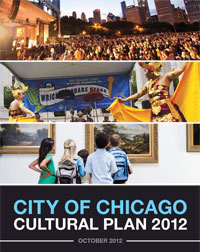|
Culture and creativity have the power to transform communities and local economies into thriving centers. Made popular in North America in the mid-1970s, cultural planning, a hybrid of urban planning, public policy, and arts administration, has been bandied about for years – achieving widespread notice when popular Chicago Mayor Harold Washington launched the City’s first "Cultural Plan" in 1986. In the mid-1990s, the European Union Treaties of Maastricht and Amsterdam required the European Commission to take into account the cultural dimension of its actions, launching cultural planning efforts across the EU and firmly establishing it as a responsibility of government. In 2009, former chair of the U.S. National Endowment for the Arts, Rocco Landesman, gifted the practice with another name – creative placemaking – and a financial incentive, in the Our Town grant, to create innovative artistic programs and stimulate the incubation of new industries, tourism and employment in cities and communities.
|
|
 One year ago, Mayor Rahm Emanuel launched the City of Chicago's first Cultural Plan in over 25 years and the impact of the Plan, facilitated by Lord Cultural Resources and led by Department of Cultural Affairs (DCASE), on everyday Chicagoans has been unprecedented. Over half of the plan’s 241 initiatives have been implemented, transforming major global events like the city' s Taste of Chicago and attracting and leveraging support from major corporations and city agencies to strengthen neighborhood cultural access. This month, Mayor Emanuel announced that the plan would receive a proposed $1.25 million in the City's 2014 budget. Rock on, Chicago!
One year ago, Mayor Rahm Emanuel launched the City of Chicago's first Cultural Plan in over 25 years and the impact of the Plan, facilitated by Lord Cultural Resources and led by Department of Cultural Affairs (DCASE), on everyday Chicagoans has been unprecedented. Over half of the plan’s 241 initiatives have been implemented, transforming major global events like the city' s Taste of Chicago and attracting and leveraging support from major corporations and city agencies to strengthen neighborhood cultural access. This month, Mayor Emanuel announced that the plan would receive a proposed $1.25 million in the City's 2014 budget. Rock on, Chicago! |
As the millennium entered its second decade and the twin menaces of shrinking manufacturing and rising fuel costs threatened the strength of cities across the globe, wise political and economic leaders turned to the resources they encountered on the streets every day – people – to uncover the next big industry. Broad acceptance of the idea that a thriving urban life is key to successful communities of the future and the yearning to attract and grow the creative economy led to the recognition of culture as the fourth pillar of sustainability – equal to the economic, environmental and social realms of a city’s vitality.
Every city has a culture, whether it is heritage, history, or simply the shared identity of the community to draw upon – artistic, historic, athletic, and religious. Culture is part of who we are and how we live and is a key component of vital communities. In recognition of this fact, developers in the fastest growing countries in the world, China and India, are refurbishing and re-branding cities as cultural havens – an effort by local governments to revitalize economies in need of urban renewal mechanisms1.
A recently released Urban Land Institute study2 revealed that Americans are abandoning relatively isolated suburbs in favor of the need and desire to be closer to schools, retail, and work – especially true among the country’s fastest growing populations – young adults ages 18-34 (Millenials) and Latino Americans.
A cultural plan, like every other plan, is about implementation. Rather than asking how to enhance culture throughout urban life, we ask how we can enhance urban life through culture. The reason the Chicago Cultural Plan, the Bilbao Cultural Strategy, the Decatur Cultural Arts Master Plan and countless others are working is because they rely on the concept of "planning culturally." This idea, made real in so many cities by Lord Cultural Resources teams working with these and other clients, relies on a ground-up strategy, beginning first with the people in the community, folding in industry and government. Here is the shameless truth: cultural plans only work when they are created and executed by the communities they serve. Priorities and initiatives – ways to fulfill the plan – are not bank-rolled by some detached fairytale benefactor; instead they are funded by private industry, foundations, government and everyday individuals as fulfillment of common goals for community sustainability and economic development.
- State of the World’s Cities Report, UN-HABITAT, United Nations Settlement Programme, 2004.
- America in 2013, Urban Land Institute, 2013.
|